Lou Christie Is 70
Luigi Alfredo Giovanni Sacco was born on this day in 1943. As Lou Christie, he is best known for the song above, which, in the scheme of things, is a pretty solid song to be best known for. There’s an eerie timelessness to it.
Burger King Twitter Outrage Caps 60 Years Of Awful Burger King Commercials
As you may have seen on Twitter yesterday, Burger King was either sold to McDonald’s or taken over by crazy people. Both would be an improvement, as Burger King has a reputation as “the fast food that even fast-food lovers don’t like at all.” There has always been something off about this hamburger franchise business, especially the marketing. That’s why cynical people looked at the supposed hacking of @BurgerKing and figured it was just another desperate try to get anyone to care about the perennial No. 2 hamburger brand.
Having utterly failed to accidentally make a creepy red-and-yellow male harlequin like Ronald McDonald, Burger King’s vulture capital owners in the 2000s created an intentionally disturbing human mascot called “The King.” People with tattoos on their necks were apparently won over by this thing, until the Great Recession made all these people unemployed. When Burger King was sold yet again, in 2010, the new owners (an investment group in Brazil) killed “The King” and fired the advertising agency that created this abomination.
A typically crappy Burger King ad, this one made poor use of a then-popular African-American singer, who would explain to the white people what was involved in making a repulsive concoction of breaded chicken waste, corn syrup sauces and a tortilla of some kind. And all the marketing money was wasted, as the commercial was pulled after complaints of “black people and fried chicken” racism.
The company’s advertisements are also horrible in England.
What cut-rate animation studio made this piece of horse shit?
“Sir Shake-a-lot,” from the days when it was still “okay” to mock those struggling with Parkinson’s Disease. This was reportedly Rush Limbaugh’s favorite commercial.
This one from 1978 featured yet another flop character, the “Duke of Doubt,” who now presides over a misogyny-based online skeptic forum.
This rare footage from Studio 54 involved the consumption of more than 7 kilograms of cocaine.
That this commercial aired within months of the “Duke of Doubt” spots is nothing less than a corporate cry for help.
In an era of vaguely hippie/integrated singers doing corporate themes for the Now People — Coca-Cola’s “I’d Like To Teach the World To Sing” set the template in 1971 — Burger King’s agency contributed the bizarre “Have It Your Way” campaign. It was catchy, so it was used to death, and by the late 1970s was better known for the Saturday Night Live parody commercial than the actual spots featuring blow-dried leisure-suited dads and moms bewildered by a new way of life: your inedible assburger could also be purchased without the pickles!
Soon There Won't Be Anything Unpretentious Left
“We’ve gone way beyond organic food, and Starbucks is passé. Organic cleaners have become a barometer.”
Boys, Boys, Boys: Fred Armisen, Jim James, Nathan Gunn, Paul Muldoon
It’s a ladies day off! An all-male program of New York City delights! Paul Muldoon talks poetry at McNally Jackson, Fred Armisen at Bowery Ballroom, Jim James at Music Hall of Williamsburg, foxy baritone Nathan Gunn at Zankel Hall — and Swann’s Way gets a 24-hour reading starting at 7 p.m. at 192 Books. Pro tip: a couple of these things look sold out, but Stub Hub comes to the rescue. (Our calendar.)
Huzzah, George Washington, Secret Basketcase And First President
Huzzah, George Washington, Secret Basketcase And First President
by Sarah Marshall and Amelia Laing
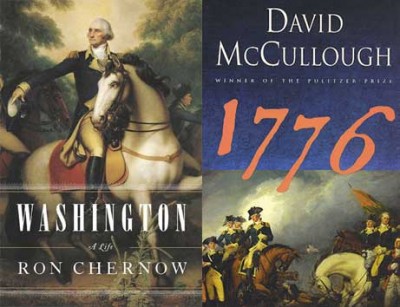
Many years ago, Sarah Marshall and Amelia Laing went to high school together. They laughed, they cried, they wore regrettable outfits to underage dance clubs. They traded books, sweaters, and anxieties, and somewhere along the way they took AP US History together, and learned, all told, surprisingly little. Now, as they make their way through a different but equally ridiculous phase of their lives, they have set out to remedy this oversight by reading biographies of all the presidents, in order. It’s going to get hairy around Harrison.
This time up, as an accompaniment to Presidents Day weekend, it’s George Washington, and the books discussed are David McCullough’s
1776 and Ron Chernow’s Washington: A Life.
Sarah: Before we start our discussion, I’d like to get all the clichés out of my system. George Washington! He was tall and regal and chomped on pounds and pounds of cherries with his wooden teeth! He invented cocaine! He could not tell a lie! He was like Ella Enchanted that way! On the Delaware! In fact, he loved cherries so much that they may have killed him! (No, wait, that was Zachary Taylor.)
Truth be told, most of what I knew about Washington before reading 1776 came from the John Adams miniseries (in which he was played by David “Brutal-Howell-from-The Green Mile” Morse), and a book I read in third grade, memorable mostly for containing a lot of guys going “Huzzah!” I still find the word deeply enthralling. I hope that Washington did, too, at least on some level, but he may have been above that.
I certainly know more about him than I did a few weeks ago — low bar! — but I have to say that Washington still didn’t seem quite like a flesh-and-blood figure to me by the end of 1776. This was probably the book’s greatest weakness, as well as its greatest strength. Though Washington is at its center, it’s certainly not a biography, and though I think David McCullough would say that Washington played a more decisive role in the revolution than anyone else in England or America, he also clearly means us to understand that Washington’s victory relied on countless other factors — as every victory does.
Amelia: Here I have to say, Mlle. Marshall, I think you kind of started Sarah and Amelia’s Presidential Year off by cheating. While you were blithely flipping through the, what, three-hundred-page 1776 (which, I want to remind our readers, is not even a biography), I was trudging through Ron Chernow’s 817-page cradle-to-grave tome, Washington: A Life.
But, no matter, I still love you. So. Washington.
Great title. Not. I don’t see why Chernow couldn’t come up with something more inventive and descriptive, such as:
Washington: He Wasn’t Hamilton’s Bitch
Washington: He Freed His Slaves in the End, Okay?!!
Washington: A Man Who Got Ahead by Shutting the Fuck Up
Washington: Author of the Most Boring Diary Entries Ever. I Mean, Really, Ever.
Title aside, Chernow does a good job of providing his readers with a comprehensive, easy-to-digest view of Washington. He starts off by stating, correctly, that history has made of Washington a marble statue, a waxwork, an unemotional, admirable, stoic figure, and that these very same qualities have made Washington… well, boring in the eyes of many.
But he wasn’t! Chernow asserts. Washington was deeply emotional. And deeply interesting. And Chernow’s going to prove it to you.
Sarah: Reading 1776 instead of a million-page-long biography isn’t cheating, it’s getting creative — just like in high school. Well, okay, maybe not exactly like high school, because I didn’t just read the first 30 pages and try to base all my opinions off them. Which is why I won’t spend all my time here talking about George III and the House of Commons, which is what McCullough focuses on in his first section- — a move that I love, and not just because historical House of Commons shenanigans are always entertaining. You may think the House of Lords was a party, but the House of Commons boasted the always memorable Edmund Burke — who, despite his sympathy for the Americans and his belief that England should attempt to make peace, still referred to them as “our” colonies — and Burke’s brilliant, foppish protégé, Charles James Fox, who, like the smartest kid in your AP History class, never did his homework and always dazzled everyone in the room. As Britain was still reeling from its losses at Bunker Hill, Fox said of the coming war that he could not “consent to the bloody consequences of so silly a contest about so silly an object, conducted in the silliest manner that history or observation has ever furnished an instance of.”
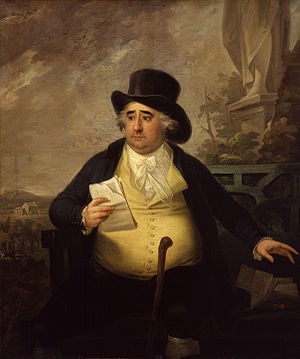
One of the questions 1776 sets out to answer is how right Fox was in his claims. He — and many others — believed the war could only end in a British defeat, and of course they were right. But his characterization of the war as “silly,” while somewhat hilarious, still raises American hackles. From elementary school on, we are trained to see the Revolutionary War as an unstintingly noble contest, illuminated by the radiant light of liberty and justice for all, for we hold these truths to be et cetera et cetera. I would even argue that, of all the wars America has fought, it is the most relentlessly glorified — more than World War II, which is still too recent a memory, and was documented too fully, so we can only see it side by side with its carnage; more than the Civil War, which we are taught to think of as necessary in deciding our natural character and ending slavery, but as having done so only through regrettable tragedy. But the Revolution is our origin story, and so it is not about slaughter and disease and endless, grinding hardship (which it was — it dragged on for twice as long as the Civil War), but about liberty, equality, and valor.
And perhaps it’s because we see the Revolutionary War in such a positive light that the Founding Fathers have become so iconic and beloved. Here is Benjamin Franklin, brilliant, soused, and slutty, flying a kite and a lightning storm with one hand and pushing a wheelbarrow through the streets of Philadelphia with the other — the Founding Fun Uncle. Here is John Adams, vinegar-lipped, articulate, uncompromising, and wise. And here is George Washington, enormous and bewigged, uniform immaculate, face hewn out of marble, the noble, flawless leader without whom the war could never have been won.
What McCullough and Chernow both do is challenge that view, both of Washington and of the war as a whole, and show them, instead, as what they were: a desolate, often miserable slog in which defeat seemed to loom at every corner, and a confused, unprepared man whose experience in war was a trial by fire — as well as ice, mud, disease, and incompetent troops.
Amelia: Washington, who didn’t cut down a cherry tree, who didn’t have wooden teeth (his dentures were made of ivory and human teeth, sometimes using the teeth of slaves), was an intensely private man who always had posterity’s opinion in mind. Given his aloofness, it’s easy to see how Washington the man became Washington the Mona Lisa gracing the American dollar bill. Not necessarily as pretty, but just as enigmatic.
Chernow wants to re-introduce his readers to Washington the man, flaws and all. In his preface, Chernow hopes that “readers, instead of having a frosty respect for Washington, will experience a visceral appreciation of this foremost American who scaled the highest peak of political greatness.” Washington: A Life is one part PR make-over, one part reverential eulogy, and one part “Washington: Behind the Music.” Washington doesn’t only deserve our respect, Chernow implies, he deserves our love. I can imagine that most biographers feel this way about their subjects, at least a little.
He generally judged a party’s success based on how many women were in attendance, counting and recording in his diary the numbers: “There were upwards of 100 ladies.”
Despite his lauding of Washington’s “unerring judgment, sterling character, rectitude, steadfast patriotism, unflagging sense of duty, and civic-mindedness,” Chernow does an admirable job of looking with a discerning eye at all aspects of Washington’s life, including the bad. His treatment of Washington and the issue of slavery is an area where Chernow shines as a popular historian, succinctly summarizing a very complex, well-worn theme:
The good: Writing in 1775 to Phillis Wheatley, a 22-year-old slave and poet who wrote “To His Excellence, George Washington,” Washington extended an invitation: “If you should ever come to Cambridge or near headquarters, I shall be happy to see a person so favour[e]d by the Muses and to whom nature has been so liberal and beneficent in her dispensations. I am with great respect your obed[ient] humble servant.”
It is a nice story, but let’s not get carried away. Yes, Washington did free his slaves upon his death, and yes, he did regard slavery as an inefficient system. He respected slave marriages, and made it a point to never separate families. But…
The bad: He made no substantive efforts during his lifetime to abolish slavery, content to leave that matter to future generations. In return for clothing and shelter, he believed from his slaves “such labor as they out to render.” Chernow relates a story of how Washington derided a slave with an injured arm. “Grasping a rake in one hand and thrusting the other in his [Washington’s] pocket, he proceeded to demonstrate one-handed raking. ‘See how I do it,’ Washington said. ‘I have one hand in my pocket and with the other I work. If you can use your hand to eat, why can’t you use it to work?’”
Whether stories like these do Washington justice or not, they certainly show a different Washington that we aren’t necessarily accustomed to seeing. While Chernow stands firm on a few points (he denies that Washington was Alexander Hamilton’s dupe, and argues that Washington was not an indecisive general, just cautious), generally this biography presents the reader with the facts and lets the reader take away what he or she will.
Sarah: McCullough certainly pays homage to Washington — 1776 centers on him, make sense, given his role in the war. However, I came away from the book far more impressed by the strength of the men he commanded — many of them incredibly young and incredibly untried. Of the Army’s march to New York, McCullough writes that “a five- or six-mile march before breakfast was usual, fifteen to twenty miles a day about average… on days of ‘wet weather’ and ‘very bad traveling,’ recorded a soldier named Solomon Nash marching with a Massachusetts artillery company, they made only about ten to fourteen miles, while moving ten brass field pieces.”
Once the Army actually reached New York, they found a city of 20,000 “crowded into an area of less that a square mile, less than a tense of the Island of Manhattan — or York Island, as it was then known… That far larger stretch north of the city, known as the Outward, was a mix of woods, streams, marshes, and great rocky patches interspersed with a few small farms and large country estates.” Lieutenant Joseph Hodgkins wrote, “This city York exceeds all places that ever I saw,” but that the cost of living was “excessive dear.” The Continental Army set up a hospital in King’s College, which had been founded in 1754 by royal charter of King George II, and was renamed Columbia following the end of the Revolution. McCullough describes it as “one of the largest, handsomest buildings in town,” though “the library books were removed, lest the soldiers burn them for fuel.”
A key to understanding this characterization seems to come with John Adams’ remark that Washington was one of the finest actors of the day.
Abutting the University was a district known as the Holy Ground, where as many as five hundred prostitutes welcomed the influx of new business brought to them by the war. Lieutenant Joseph Bangs took it upon himself to investigate the Holy Ground’s brothels — ostensibly in order to ensure his men’s safety — and wrote that “at first I thought nothing could exceed them for impudent and immodesty, but I found the more I was acquainted with them the more they excelled in their brutality.” Soon after the Continental Army’s arrival, the bodies of two dead soldiers were found in a Holy Ground brothel, one, Bangs wrote, “castrated in a barbarous manner.” This information presents only half a picture of occupied York Island, however, as McCullough also notes drily that a British officer “was cheered…but the number of soldiers being court-martialed for rape, this being perfect proof, he wrote, of…what a ‘spirited’ lot they were.”
Little details like these are my favorite part of any book, and without a doubt they’re my favorite part of 1776. Throughout McCullough’s wide-ranging discussion of pettish Englishman, underfed soldiers, and the women who played minor yet heroic roles throughout the war — among them Molly Corbin, who went into battle at Fort Washington alongside her husband, and took his place in action after he was killed — Washington remains somewhat aloof, and it seems McCullough would like to keep it that way.
A key to understanding this characterization seems to come with John Adams’ remark that Washington was one of the finest actors of the day. McCullough’s use of Washington’s private writing throughout the year shows beyond a shadow of a doubt that Washington was almost unceasingly besieged with fear and anxiety. In late September, Washington wrote, “Such is my situation that if I were to wish the bitterest curse to an enemy on this side of the grave, I should put him in stead with my feelings… I never was in such an unhappy, divided state since I was born.” Following his surrender of Fort Washington, he wrote to his brother that he was “wearied almost to death with the retrograde motion of things.”
Amelia: Washington: A Life also gives us a fuller picture of the country’s first president: the man who the Continental army together was also highly embarrassed of his teeth. Of Washington’s relationship with dentist Dr. Jean-Pierre Le Mayeur, Chernow writes, “he handled their relationship as furtively as if he were meeting a master spy…never mentioning such explosive words as dental or dentures in case unfriendly eyes stumbled upon it.”
The man who roused the Continental Army with the “fate of unborn millions will now depend, under God, on the courage… of this army,” was awkward and stiff in the company of men, but quite at ease with women. He generally judged a party’s success based on how many women were in attendance, counting and recording in his diary the numbers: “There were upwards of 100 ladies. Their appearance was elegant and many of them were very handsome.” Kind of weird.
Sarah: And also much more like the behavior we expect from modern politicians — a comparison that can allow us to realize how dangerous it is to compare our current leaders to highly mythologized historical figures.
Amelia: Chernow’s biography pulls Washington off his pedestal, only to put him back on it with more realistic reverence. Reading Washington: A Life is a little like falling in love. And true love, as we all know, involves early-morning flatulence, annoying tics, and usually terrible in-laws. But the things we tolerate, we come to love, and so it is with the Washington who emerges here.
Sarah: Reading 1776 made me wish I could also read 1777–1783, but McCullough is, to be fair, a busy guy.
PRESIDENTIAL VERDICT
Read David McCullough’s 1776 if: You want an overview of the first year of the war, including its bit players and down and dirty details; you want to reassure yourself that going back in time to find cheaper rent on “York Island” isn’t a good idea; and you want to get a sense not just of Washington and his struggle but of the men who comprised the Continental Army, and of daily life in America in the very first year of its existence.
Read Ron Chernow’s Washington: A Life if: You want a wide-ranging introduction to the man behind the myth.
Next up in series: David McCullough’s John Adams (Sarah) and John Ferling’s John Adams: A Life (Amelia)
Related: Literary Vices, Rudolph Delson’s tour of the canon of vice-presidential literature, including Dan Quayle’s Standing Firm and Richard Nixon’s Six Crises
Sarah Marshall enjoys cooking presidential foods, and Amelia Laing enjoys eating them.
New York City, February 14, 2013
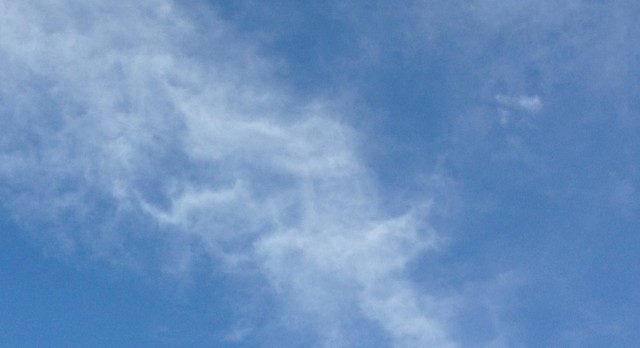
★★★ Drips were still falling from the old scaffolding, and the way out of the dripline was impeded by a crew putting up an adjoining new scaffold. Birds twittered somewhere by Broadway. A man walked up Lafayette with his gloveless hand holding a gold-ribboned gold box flat and carefully. A puff of air from the subway grate met so little resistance that it still felt warm when it reached the face. Cut roses, in no danger of being hurt by the chill, flanked the sidewalk. Out the conference-room windows, the late clouds were silver wisps and custard-colored stipples. Gray shaded in among them as the minutes passed. Outside, finally, there were pink patches overhead, with a slim white crescent moon beside them.
Two "Black"-Hearted Drinks From Cold, Dark, Faraway Places
Two “Black”-Hearted Drinks From Cold, Dark, Faraway Places
by John Ore
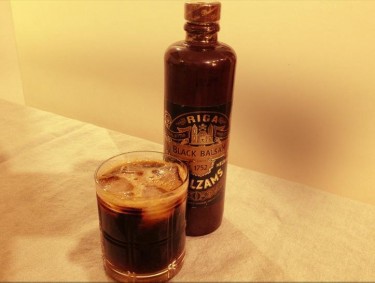
A good friend of mine insists that having a nice meal while you’re traveling is considered sightseeing. Since I’ve had the privileges of accompanying him at nice meals in places like Moscow, Prague and Budapest, I tend to agree: food’s as important an entry point to any new place as art or architecture. As a corollary, though, I’d submit that another essential part of experiencing a foreign culture is getting drunk on the local hooch. Now, I don’t want to come off all Anthony Bourdain-y here — hey, look at me! I travel! I drink! — especially since Bourdain is a huge wimp for claiming that hakarl was “the single worst, most disgusting and terrible tasting thing” he’d ever eaten (more on that later). Has he never eaten Guy Fieri’s Cajun Chicken Alfredo? Still, I’ve been lucky to travel a bit, and stunt-drinking native booze is always high on the itinerary.
Sure, it’s fun to bring Jameson back from Dublin, or Dolgoruki Vodka back from Moscow. Even the Lithuanians make their own vodka. But you can get those in the States. Some people collect snow globes or fridge magnets from their travels. I collect little bottles of booze.
I’ve enjoyed slivovice in Prague, as well as with a friend with Czech parents in California. It was equally awesome in both places. I brought palinka back from Budapest (along with bull’s blood wine). These are strong drinks, brandies made from plums and pears, local moonshine. People offer them as a dare, I take them up on it.
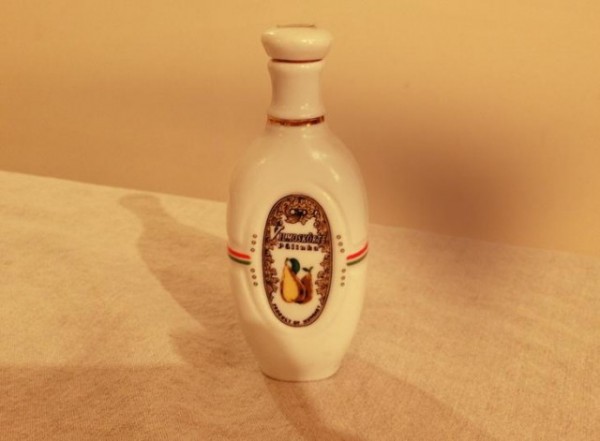
In Croatia, the fruit-based brandy rakija comes in a wide variety of flavors, including the grappa-like travarica (grape brandy infused with herbs) and rogačica, which is infused with carob pods. I bought bottles of both from a garage on the side of the road in Pitve, on the island of Hvar. This was as local as it got: they were offered in recycled soda and Jana water bottles, homemade labels and all.
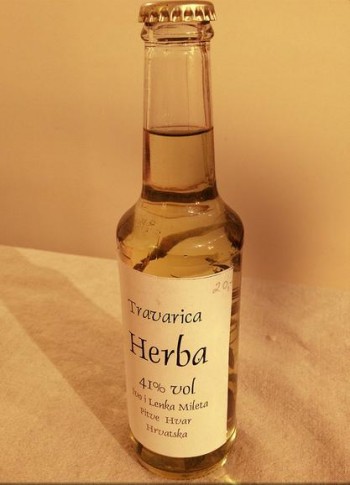
In terms of its uniqueness, nothing beats Latvia’s Rīgas Melnais balzams (“Riga Black Balsam”). At a robust 90 proof, balzams offers “subtle hints of linden blossom, birch bud, valerian root, raspberry, bilberry, and ginger as well as touches of nutmeg and black peppercorn tease the palate and come alive in the glass.” It is alleged to have cured Catherine the Great when she fell ill during a trip to Latvia and all else failed. Who could argue with that?
Apparently, most people. My father, who was born in Riga, Latvia, doesn’t really like the stuff. Most people I’ve forced it on conclude that it’s like drinking iodine. I love it. It’s a part of my pre-Drynuary preparations on New Year’s Day. Bonus: it comes in clay bottles, so you know it’s authentic/dangerous.
Similarly, in the tradition where most local rotgut attempts to scare off the initiated with a spooky name like “Black Death,” the Icelandic schnapps known as brennivín is actually a lovely, rich, almost sweet, caraway-flavored delight. The moniker “Black Death” was apparently bestowed by temperance advocates to scare people off: like most schnapps, brennivín is less potent than your standard 80-proof whiskey. It’s got a warm, rye-bread aroma, is fantastic served ice cold with a beer, and is a famous accompaniment to the aforementioned infamous hakarl.
Ready to get your passport stamped? Here are some simple ideas for enjoying the black fruits of your fellow citizens of the world — pick these liquors up as you travel or follow the links in the recipes to order online.
RIGA BLACK BALSAM
To Drink: Most serving suggestions for balzams tend toward pairing it with something caffeinated, like Coca Cola or coffee. These are invariably great, but they aren’t quite cocktails.
Dark and Windy
• 2 oz. Riga Black Balsam
•1 tsp. fresh lemon juice
• 4 oz. ginger ale
In a rocks glass, add lemon juice and balzams over ice, top with ginger ale. Garnish with lemon wedge and serve. The Wind was born in Liepaja, Latvia, you know.
To Eat: Latvian piragi, naturally. Doughy, bacon-y savory rolls chock full of eastern European goodness, a nice counterbalance to the bitterness of the balzams. Plus, you really need a nice base in your stomach if you’re going to start mainlining balzams for the evening. Preferably while listening to Latvian pop sensations Tumsa or Prāta Vētra.
BLACK DEATH
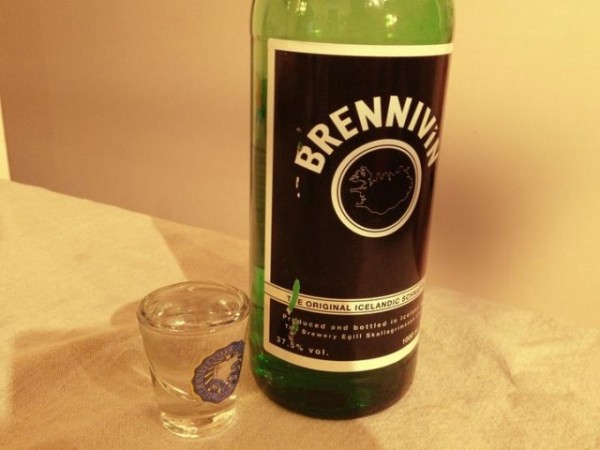
To Drink: Brennivín typically gets quaffed solo, ice cold, maybe with a beer back. Make no mistake, it’s great that way, nice and simple. But I’ve also had it in an Icelandic coffee (self-explanatory), and tried it with eggnog during the holidays instead of bourbon or rum. The caraway flavor is perfect with dairy, like rye toast with cream cheese. Believe or not, it works.
Another Caucasian, Geir
• 2 oz. brennivín
• 1 oz. Kahlua liqueur
• Half-and-half
In a rocks glass, add brennivín and Kahlua over ice. Top with half-and-half, stir and serve. Your roll.
To Eat: I was “fortunate” enough to try hakarl in Reykjavik last Fall. Just as a favorite Ukrainian restaurant in Lithuania (I know, right?!?!?) suggests serving a boot-shaped shot glass of vodka with every beer (“Beer without vodka is a waste of money”), hakarl and brennivín go hand-in-glove. When I asked our waiter whether the brennivín was supposed to enhance or mask the flavor of rotten fermented shark, he replied “both.” Right he was.
Hakarl is awesome, if nothing more than as an experience. Granted, I had it in a nice restaurant in Reykjavik — along with puffin — but methinks that Bourdain and Ramsey and others are just being dramatic for the sake of their personae (Ramsey is rumored to have puked after eating it, which is astonishing if you’ve ever seen him choke down bad Long Island Italian food on “Kitchen Nightmares”). The aroma is as advertised: ammonia and cat piss and wet hockey equipment. Soldiering on past that, if you’re able, the cubes of Greenland shark meat were a bit spongy with a chewy core. The taste isn’t that bad, not too fishy. The upsetting part is exhaling strong ammonia fumes out of your nostrils like a dragon as you chew: you really do get the strong sensation that you’re deliberately poisoning yourself. Adding a sip of straight brennivín completes this sensation, although it mellows the aroma considerably. It pleases the elves.
Overall, I’d definitely try it again. Everyone should try it once.
Related: Sorel Cocktails
John Ore drinks globally, acts locally.
Bunny Big
“A petrified burglar fled a family home in the middle of the night — after coming face-to-face with their giant pet rabbit.” There is a photo.
A Poem By Paula Mendoza
by Mark Bibbins, Editor
Someone No One Everyone Anyone
and I put all this blood in, but things just get sticky
No one’s a mess anyone
wants to pick up after, so I marched my ass down
to the shack that flashed
LIVE MODELS in red and asked if they needed
someone good with light.
Everyone was bronzed
and someone was covered in glitter.
“Here,” I said, “hold
that glow
lower” and motioned to someone
who shone a weird green
light too high
the shadows made everyone’s eyes onstage look
like pulsing suckholes.
Limbs in that angle
seem tentacled with darknesses.
I tsked, “That’s no way to shine a body.”
Paula Mendoza’s poems have appeared or are forthcoming in PANK, elimae, and The Offending Adam. She has an MFA from the University of Michigan and currently lives in Austin, TX.
Do you need a poem with which to charm the Valentine for whom you forgot to get a gift? There is sure to be something in here that will work. You may contact the editor at poems@theawl.com.
Penis Metric Story Provides Teachable Moment
What’s nice about this headline is grandparents can tell their grandchildren what “Chubby Checker” is, while grandchildren can explain “penis app.”
